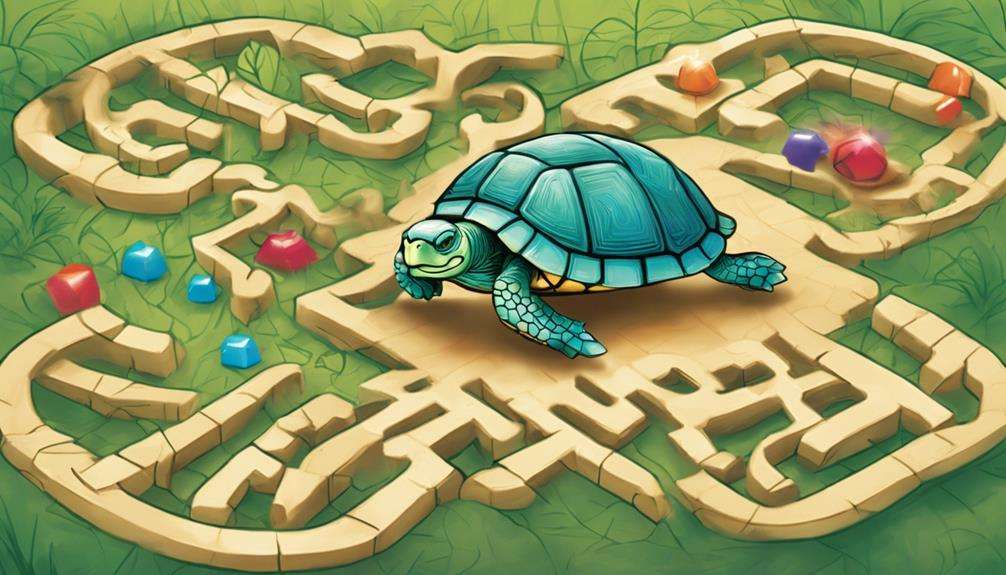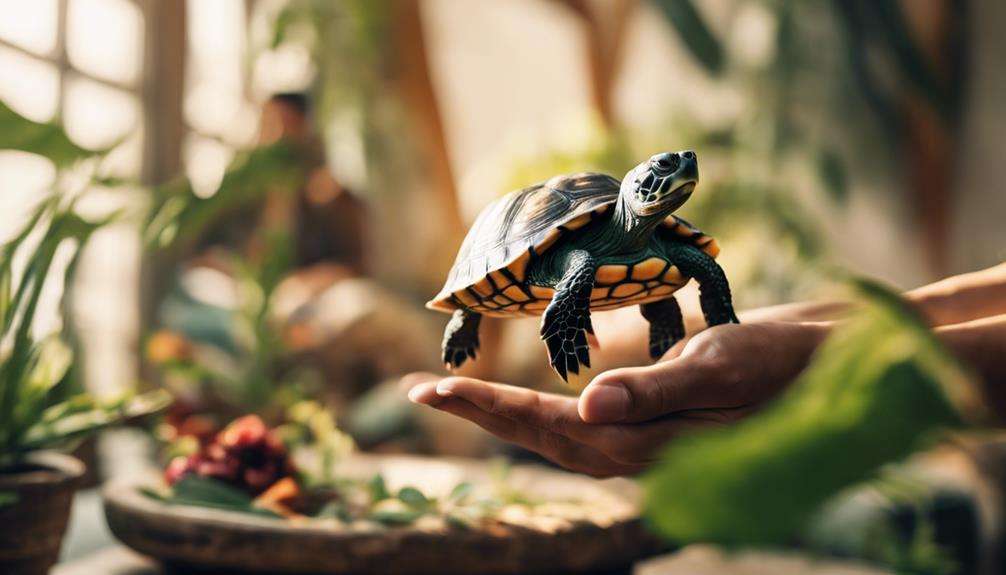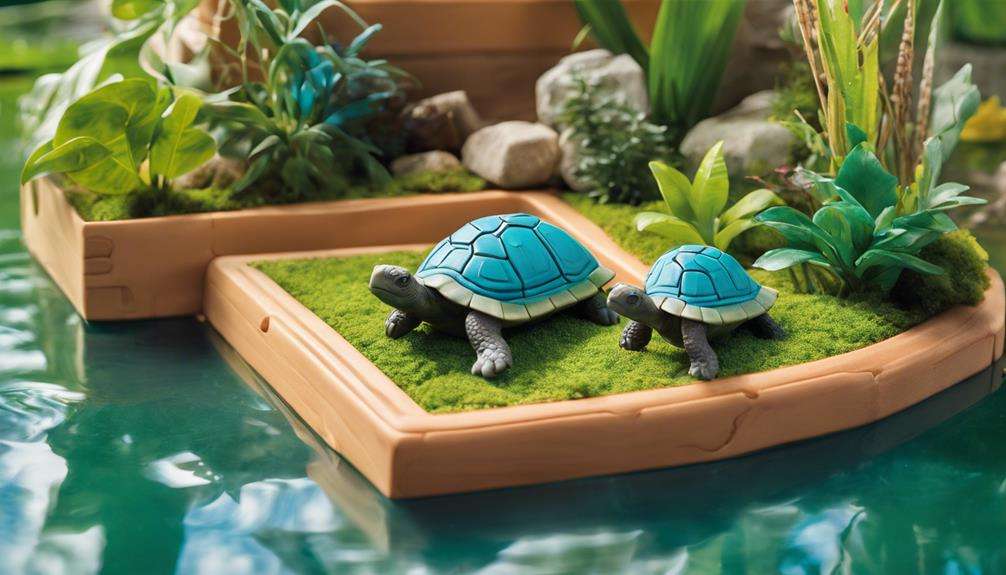When it comes to training your unusual turtle pets, remember that 'slow and steady wins the race.' Implementing the best techniques can lead to a fulfilling companionship with your unique pet.
From targeted feeding for behavioral conditioning to bonding exercises for trust building, each method plays a vital role in their development.
Discover how these effective strategies can enhance your relationship and bring out the best in your extraordinary turtle companions.
Key Takeaways
- Targeted feeding and positive reinforcement enhance training effectiveness.
- Enrichment activities provide mental stimulation and prevent boredom.
- Clicker training facilitates clear communication and strengthens behavior-reward connections.
- Bonding and trust-building techniques are essential for a strong owner-turtle relationship.
Targeted Feeding for Behavioral Conditioning
To effectively condition desired behaviors in unusual turtle pets, implement target feeding strategies that focus on specific feeding locations or methods during training sessions. When considering turtles in the world, the common snapping turtle stands out for its unique characteristics. Even though snapping turtles are known for their aggressive nature, with proper training techniques, these turtles can also exhibit positive behaviors.
Targeted feeding plays an important role in training common snapping turtles. By associating specific feeding locations or methods with desired behaviors, you can effectively condition them to respond positively during training sessions. Despite their reputation, common snapping turtles can learn to engage in interactive activities when provided with the right incentives. Offering treats during training sessions serves as a form of positive reinforcement, encouraging these turtles to display the desired behaviors consistently.
Adjusting feeding schedules to align with training routines is essential for best results. Monitoring their feeding responses allows you to gauge progress and make necessary adjustments to your training techniques. With targeted feeding strategies, even common snapping turtles can be trained to exhibit positive behaviors.
Positive Reinforcement for Desired Behaviors
Using positive reinforcement is an essential training method for encouraging desired behaviors in your turtle, whether it be coming to you when called or following specific commands. Positive reinforcement involves rewarding your turtle with treats or praise when it displays the desired behavior.
You can enhance this training by incorporating a clicker or a specific sound cue along with treats to help your turtle associate the sound with the reward, leading to better training outcomes. Consistency is vital in positive reinforcement training to strengthen the connection between the behavior and the reward in your turtle's mind.
Enrichment Activities for Mental Stimulation

To engage your unusual turtle pet's mental faculties and enhance their well-being, consider incorporating enrichment activities that provide stimulation and promote natural behaviors. Interactive puzzles and sensory exploration can stimulate your turtle's problem-solving skills. Creating a natural habitat simulation with live plants, rocks, and branches encourages foraging fun, allowing your pet to exhibit its instinctual behaviors. Rotating toys, objects, and climbing structures in the tank prevents boredom and promotes exploration, keeping your turtle mentally active.
Introducing problem-solving challenges and enrichment variety in your turtle's environment is crucial. You can set up a 'dig box' with safe substrate to allow your turtle to exhibit digging behaviors, providing both enrichment and mental engagement. Additionally, incorporating new scents, textures, and sounds in the turtle's surroundings can engage their senses and keep them mentally stimulated. By offering a diverse range of activities that mimic their natural behaviors, you can make sure your unusual turtle pet stays mentally sharp and happy.
Clicker Training for Clear Communication
To summarize, clicker training with turtles involves utilizing a clicker as a marker for desired behaviors, aiding in clear communication and precise timing during training sessions. By associating the click sound with positive reinforcement like treats, turtles quickly grasp which behaviors earn rewards.
This method not only improves communication but also helps in providing effective training by clearly indicating to the turtle when they've performed the desired action. The clicker serves as a bridge between the behavior and the reward, making it easier for the turtle to understand what's being reinforced.
Through consistent clicker training, turtles can learn complex behaviors and respond to specific behavioral cues more readily. This form of training is particularly effective in strengthening the bond between the turtle and the owner, as it establishes a clear channel of communication and mutual understanding.
Bonding Exercises for Trust Building

For fostering a strong bond and trust with your turtle, regularly engaging in bonding exercises is important. Interactive games are a fun and essential way to build a connection with your pet. These games can include activities like gently moving your fingers in front of your turtle for it to follow or providing safe objects for it to investigate.
Trust exercises, such as hand-feeding your turtle treats, help establish positive associations and strengthen the bond between you. Socialization techniques, like speaking to your turtle in a soothing tone and allowing it to explore its surroundings under your watchful eye, create a sense of comfort and familiarity.
Consistent care, attention, and affection are vital components in developing a trusting relationship with your turtle. Remember, patience is key as trust-building takes time, but with dedication and these bonding exercises, you'll be on your way to a strong and enduring bond with your unusual turtle pet.
Frequently Asked Questions
What Tricks Can You Teach a Turtle?
You can teach your turtle agility by setting up obstacle courses, practice shell stacking for mental stimulation, and organize swimming races for exercise. These tricks enhance their physical abilities and keep them mentally engaged and active.
How Do I Get My Turtle to Trust Me?
To help your turtle trust you, spend quality time together, hand-feed for bonding, and respect its boundaries. Be patient, calm, and avoid startling it. Through effective communication and consistent interaction, you'll build trust and gain confidence.
How Do You Bond With a Pet Turtle?
To bond with your pet turtle, engage in turtle enrichment activities, practice gentle turtle handling techniques, and use effective turtle communication methods. Spend quality time together, show care, and establish trust through positive reinforcement.
What Makes Turtle Happy?
To make your turtle happy, guarantee their enrichment needs are met with varied activities, a well-designed habitat, and a balanced diet. Observing their behavior and providing UVB lighting for calcium metabolism are also key for their well-being and contentment.
Conclusion
To summarize, implementing these top training techniques for unusual turtle pets can help you build a strong bond and communicate effectively with your shelled companion.
By utilizing targeted feeding, positive reinforcement, enrichment activities, clicker training, and bonding exercises, you can guarantee a happy and well-trained turtle.
So, don't be shell-shocked by the challenge – get creative, get started, and watch your unique pet thrive!






